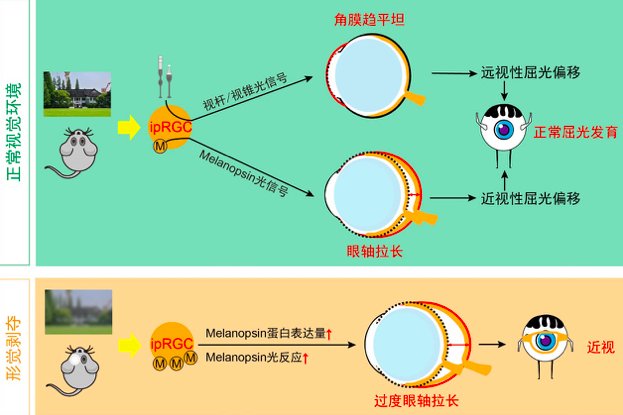
The research team led by Academician Yang Xiongli from the Institute of Brain Science, Fudan University/State Key Laboratory of Medical Neurobiology, recently investigated the mechanism of myopia. The research has made important progress, revealing for the first time the important role of a special type of retinal ganglion cell, ipRGC, in the formation of myopia. The paper was published on June 8 in the international authoritative comprehensive scientific journal “Science Advances” p>
Myopia is a very common visual disorder with increasing incidence, affecting one third of the world’s population. The study of myopia mechanism is the basis for establishing effective myopia prevention and control strategies. Among the many studies on the mechanism of myopia, the team of Academician Yang Xiongli has taken a unique approach and focused on the role of ipRGC.
These cells are a special type of retinal ganglion cells. They act as output neurons to transmit photoreceptor signals to the visual center; not only that, but they also express a unique visual pigment— – The substantia nigra is itself sensitive to light, so it is called “self-sensing retinal ganglion cells” (ipRGC). Discovered in the early 2000s, this type of cell was named one of the “Top Ten Scientific Breakthroughs” in 2002 by the journal Science.
Under the guidance of Academician Yang Xiongli, Researcher Weng Shijun and Researcher Zhong Yongmei led a team of postgraduates, based on the mouse myopia model of form deprivation, and applied multidisciplinary technology to investigate the effects of ipRGC on the refractive development and changes in mice. The role of myopia in the formation of myopia has been systematically studied.
Experiments showed that selective destruction of mouse ipRGCs with immunotoxins or specific activation of them by chemogenetic techniques resulted in significant myopic or hyperopic refractive shifts in developing mice, respectively. . Further experiments showed that the substantia nigra signal and conventional photoreceptor signal contained in ipRGC affect the development of the eyeball by modulating the axial length and corneal curvature, respectively.
It is especially worth noting that the expression level of substantia nigra protein in ipRGCs of form-deprived eyes and the amplitude of the light response mediated by them were both up-regulated. The effect of form deprivation-induced myopia was significantly reduced after down-regulation of substantia nigra activation in an environment where 480 nm wavelength light (the maximum excitation wavelength of the substantia nigra) was absent.
This work clearly clarifies the important role of ipRGC in eyeball development and myopia formation for the first time.
Yang Xiongli, Weng Shijun, Zhong Yongmei are the co-corresponding authors of the paper, 12 graduate students and technicians participated in this research, and Liu Ailin is the first author of the paper.
Author: Tang Wenjia
Editor: Tang Wenjia
p>
Responsible editor: Fan Liping
*Wenhui’s exclusive manuscript, please indicate the source for reprinting.